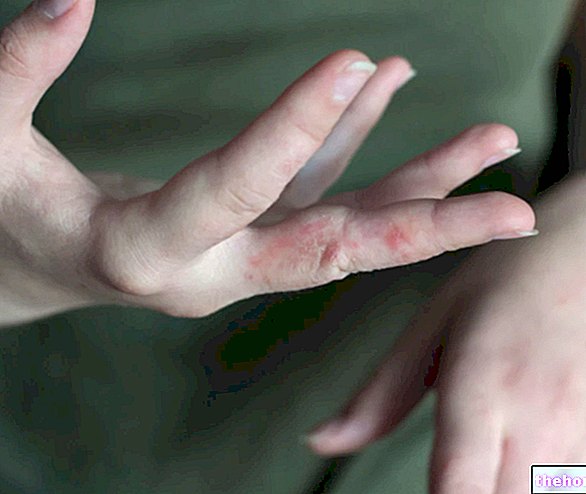What is TSS?
Toxic Shock Syndrome (TSS) is a multisystem inflammatory response, caused by bacterial strains capable of producing certain types of exotoxins.
.jpg)
Alongside the form of toxic shock syndrome associated with the use of tampons, there is a "non-menstrual" form, related to serious infections, even of nosocomial origin. In some circumstances, the bacteria grow rapidly and activate an immune response that triggers the dramatic onset of a combination of symptoms: high fever, widespread erythematous rash, sharp drop in blood pressure, etc. Bacterial exotoxins can cause involvement of other organs in the body and become complicated with a series of events that can lead to death. early diagnosis and appropriate treatment prevent disease progression and possible complications, with a good chance of recovery.
Causes
The exact cause of TSS is unknown, but most cases are associated with an "infection due to strains of Staphylococcus aureus. The toxin most frequently implicated in the pathogenesis of toxic shock syndrome is TSST-1 (toxic shock syndrome toxin-1), produced by Staphylococcus. This - together with other types of bacterial toxins, such as staphylococcal enterotoxin B or C or the pyrogenic exotoxin produced by Streptococcus pyogenes (Group A β hemolytic streptococcus) - belongs to the category of so-called superantigens. These particular molecules are able to directly activate a very high immune response compared to normal antigenic stimulation. The outcome of the reaction results in the release of large amounts of cytokines and other chemical mediators, which produce fever, rash, tissue damage and shock.
It is important to consider that the colonization of pathogens participates in the genesis of toxic shock syndrome, but it is not a sufficient factor to determine the clinical picture of the condition, which always remains a "rare occurrence. Staphylococcus aureus it is a commensal of human skin and mucous surfaces and as such can normally exist in different parts of the organism, without causing infection or disease (colonization). However, individuals who have not developed antibodies to TSST-1 (or to other toxins) can develop toxic shock syndrome. Infections from Staphylococcus aureusThey can also develop as a complication of other localized or systemic infections, such as pneumonia, osteomyelitis (bone infection), sinusitis, and skin wounds (such as surgical incisions or burns). Streptococcus pyogenes (STSS) can occur as a secondary infection, such as influenza A, chickenpox, or bacterial cellulitis (infections of the skin and underlying tissues).
Risk factors
"Non-menstrual" toxic shock syndrome occurs in men and women of all ages and is usually caused by localized or systemic infections.
Most cases of "menstrual" toxic shock syndrome are associated with the use of tampons, however the condition is now relatively rare.
The exact etiology of toxic shock syndrome has yet to be defined, but cases have been associated with:
- Super absorbent internal pads;
- Prolonged use of antibiotics;
- Staphylococcal or streptococcal infections, especially in the presence of skin wounds or surgical incisions, even when the inflammatory reaction seems minor;
- Some contraceptive methods to be inserted into the vagina: vaginal diaphragm and contraceptive sponge (cylindrical polyurethane sponge soaked in a spermicide, to be inserted into the vagina before sexual intercourse);
- Damage to the skin (burns or scalds);
- Gynecological infections and / or puerperal sepsis (severe infection of the uterus, which occurs after childbirth or an abortion).
Use of the tampon. Researchers don't know exactly how tampons can cause toxic shock syndrome. Some believe that when superabsorbent pads are left in place for a long time they can become a breeding ground for bacteria. Another theory suggests that tampon fibers can scratch the walls of the vagina, making it easier for bacteria or their toxins to enter the bloodstream. No evidence has been found to support these hypotheses.
Symptoms
Toxic shock syndrome has a very severe clinical course. If staphylococci or streptococci are the cause, symptoms develop suddenly and worsen rapidly over a short period of time. Typically, in the "menstrual" forms, onset occurs within the 3rd-4th day of period, with a sudden "fever, above 38.9 ° C. Blood pressure drops to dangerously low levels and is associated with the onset of dizziness. Other clinical signs then develop rapidly, over the course of a few hours. These may include: chills, vomiting, sore throat, diarrhea and muscle aches. After 1-2 weeks, a typical peeling of the skin (similar to the result of a sunburn) may occur on the palms of the hands and soles of the feet. In streptococcal toxic shock syndrome, the wound is painful and gangrene can develop around the infected lesion. When the source is a staph infected swab, the syndrome can recur, usually within 4 months of the first episode. An important feature of TSS is that it presents, in fact, a tendency to relapse, even if - fortunately - each episode tends to be less severe than the first infection. To reduce the risk of reinfection, women who have had the syndrome should not use internal tampons. Relapses have been reported in approximately 30-40% of cases.
The clinical signs most frequently encountered in toxic shock syndrome are:
- Sudden high fever (38.9 ° C or higher);
- Hypotension (systolic blood pressure <90 mmHg);
- Coagulopathy, with bleeding problems;
- Chills;
- Nausea, vomiting and / or diarrhea;
- Widespread rashes on the body similar to erythema, particularly on the trunk, face, palms of the hands and soles of the feet;
- Confusion and disorientation;
- Abdominal pain and vaginal discharge
- Muscle aches or weakness
- Redness of the eyes, throat and vagina
- Headache or dizziness
- Swelling of the face and eyelids.
Initial symptoms may improve, but the disease can continue to progress and cause damage to many organs.Several organs such as the kidneys, liver, heart and lungs may malfunction or develop organ failure (inability to meet the demands of the body).
Possible serious complications of TSS include:
- Respiratory difficulties;
- Loss of consciousness;
- Rhabdomyolysis;
- Gangrene;
- Pancreatitis;
- Cardiomyopathy;
- Acute liver failure;
- Encephalopathy and cerebral edema;
- Thrombocytopenia and marrow suppression;
- Disseminated intravascular coagulopathy (DIC);
- Metabolic acidosis and electrolyte disturbances.
When streptococci are involved, the syndrome can be fatal up to 70% of cases, while if the infection is due to staphylococci, about 5% of patients can die if the form is "menstrual" and 15% if not. If people are treated within a short time, recovery is usually complete.
When to see your doctor. If a sudden fever develops and one or more of the other symptoms listed above, it is still extremely unlikely that the patient will have TSS. However, these clinical signs should never be ignored and it would be advisable to contact your doctor immediately to ascertain your condition, listing the symptoms and the timing of their occurrence. If a tampon is in the vagina, remove it immediately. Also, tell your doctor if tampons have been used or if you have developed a "skin infection, such as a boil or blister that has become infected."
Diagnosis
Toxic shock syndrome is diagnosed by identifying typical symptoms, performed by a comprehensive physical exam (which includes a pelvic exam in women), by blood work, to look for the presence of a "staph or strep infection." , and through evaluation of renal and hepatic function. Blood cultures are positive in 5-15% of cases of toxic shock syndrome. Urinalysis may show microscopic hematuria and myoglobinuria. The doctor may also perform a throat (or vaginal) swab when there is a clinical suspicion of an outbreak of infection. Other tests may be done to rule out other medical conditions.
The definition of toxic shock syndrome requires the presence of the following clinical criteria:
- temperature > 38.9 ° C;
- low blood pressure (with fainting or dizziness on standing);
- widespread erythematous rash;
- skin peeling, 1-2 weeks after the onset of the disease;
- multisystem involvement (evidence of 3 or more infected organs):
- Gastrointestinal: vomiting and / or diarrhea;
- Muscle: severe muscle pain and increased CPK (creatine phosphokinase);
- Hepatic: decreased liver function;
- Renal: increase in azotemia, urea and creatinine values;
- Hematological: thrombocytopenia (also evident from the appearance of bruises);
- Central nervous system: disorientation or disturbances of consciousness;
- Mucous membranes: redness of the eyes, mouth and vagina, due to the increase in blood flow in these areas.
Treatment
Specific treatment for Strep and Staphylococcal Toxic Shock Syndrome is established by the physician based on:
- Patient's age, general health and medical history;
- Infectious agent;
- Extent of the disease;
- Expectations for the course of the disease.
There are two important goals in the treatment of toxic shock syndrome: fighting the infection and supporting the functions of the organs that have been affected, to reverse the deterioration process. The patient needs immediate hospitalization, in an intensive care unit. . Most people respond to treatment within a couple of days, but the condition can take several weeks to restore to good health.




























